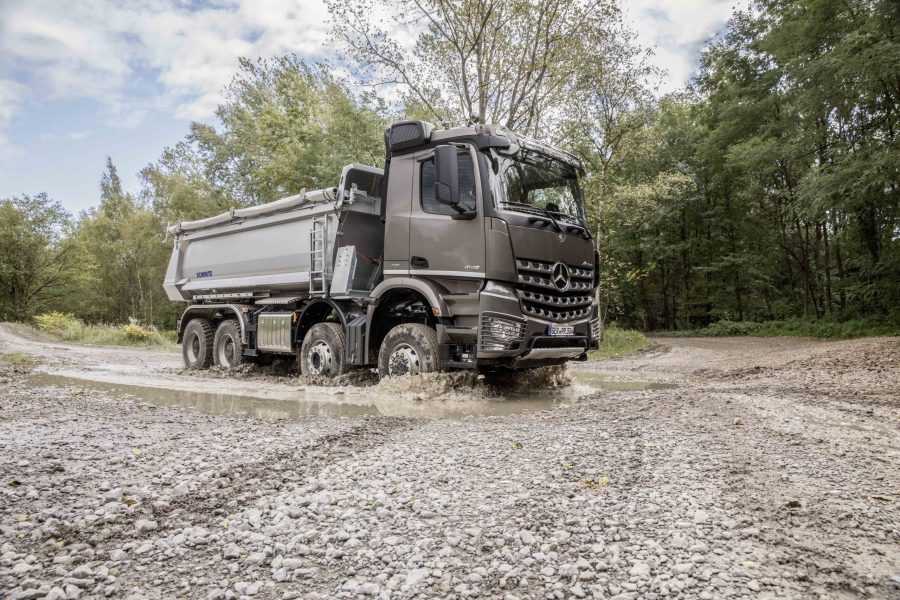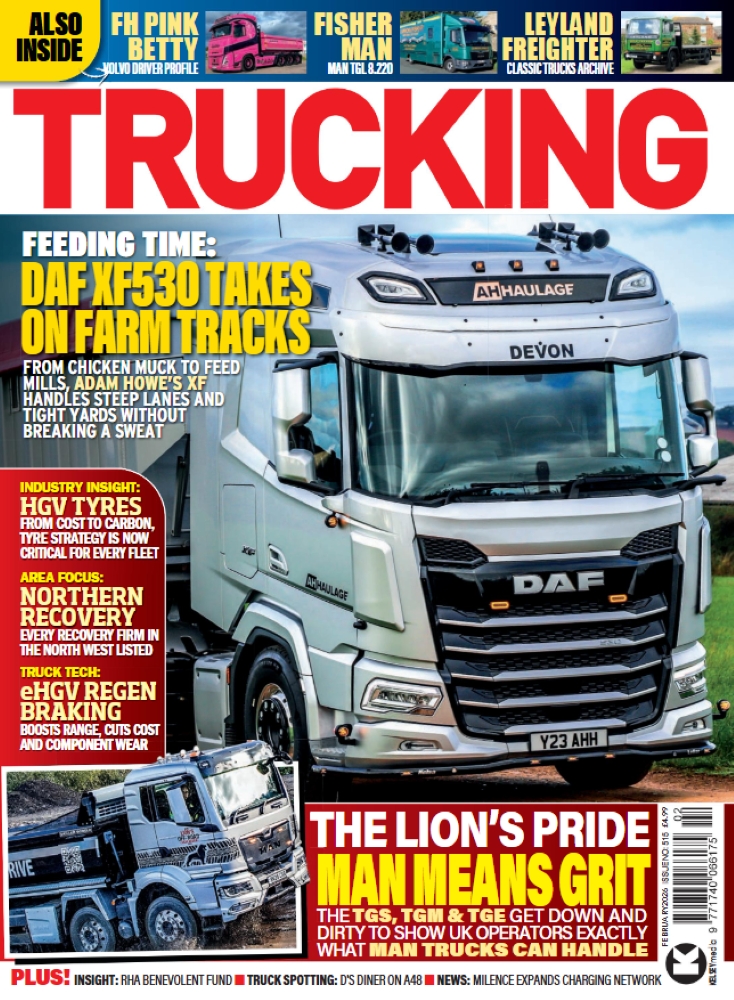We put the rugged and robust construction Arocs trucks from Mercedes-Benz to the test off and on the highway.
For many years, trucks for working off-road were just beefed-up versions of existing models. While that is still true to a degree, most manufacturers now offer bespoke ‘tough’ chassis ranges for those who have to bridge the gap between road and off-road running. Trucks that are tough enough to go into quarries, boggy construction sites and off-road, yet not so heavy that the minute they get on the tarmac, they are ‘a bit too porky’ and so affecting payloads.
One of the most popular ranges in this heavy-duty market sector is the Mercedes Arocs, which goes head to head with the likes of Volvo’s FMX, Scania’s XT and Renault’s Range K.
Like everything Merc offers, the choice in the Arocs range is very wide. For example, you can have it as an 18-tonner 4×2 rigid right through to a 250-tonne heavy-haulage tractor – and just about everything in between. Excluding heavy-haul applications and looking at the ‘typical’ truck models, Arocs is available as a four-, six- and eight-wheel rigid and a four- or six-wheel tractor. The latter can be 6x2s – tag and pusher axles – and 6×4 double drives, popular in the landfill sector in the UK.
Arocs can be specified for general haulage, though Merc dealers will listen to your requirements, talk you through the options and steer you towards the truck that best suits your needs – which will most likely be an Actros in that case. But for plant moves, landfill and moving-floor trailer work, an Arocs tractor might be a better bet.
So, from a 4×2 18-tonne skip truck through to a 6×4 tractor, the Arocs has it all. It has a wide range of cabs – day, rest and sleeper, even high-roof sleepers. There are four engine sizes from 7.7- to 15.6-litres, and 18 outputs from 238-625 bhp. Providing it can physically be done, Merc will build pretty much any Arocs you want.
MirrorCam
Like the Actros, the Arocs range from this year will be available with the revolutionary – and very impressive – MirrorCam option where the wing mirrors are replaced by cameras on stalks. This could be a real winner for trucks like this which frequently run the risk of having mirrors hit or even knocked off by trees, diggers etc.
Trucking went to Germany’s beautiful Black Forest to try out a range of Arocs, and while most of the vehicles we drove were German-spec and hardcore heavy-duty trucks designed with plenty of off-road work in mind, there was plenty to experience which British hauliers would find useful.
We headed to a quarry in Ötigheim, about 15 miles away from Karlsruhe in the south west of the country, to try the trucks out – and we were especially keen so see some of the specialist safety and traction features now available.
A wide choice
Mercedes had laid on a really varied mix of trucks for us to try, and while we would have loved to have driven them all, sadly there just was not the time. There was a good variety of drivelines, including 4×2, 4×4, 6×4, 8×8 and also rigids and tractors. Unfortunately, the one vehicle that really would have got the UK hacks fighting with each other to get behind the wheel – ie, a typical 8×4 muckaway tipper – was not present. Instead there were a number of German-spec short-wheelbase, eight-wheel tippers.
The first truck we took round the quarry test track was a 4148K 8×6 tipper which had the 12.8-litre OM471 straight-six delivering 476 bhp and 2300 Nm of torque. This truck weighed 10.8 tonnes and is capable of grossing at 41 tonnes. Again, it is unlikely to be sold to the UK market, but the 8×4 3548K at 32 tonnes might well be. Nevertheless it was still worth having a drive.
For UK muckaway operations, this kind of chassis has plenty of scope to take some serious punishment in quarry applications. The high-performance engine brake was a useful feature for such work.
It had a single-disc clutch on its Powershift 3 12-speed gearbox. This also has a manual override function and can also be operated in off-road automated mode. In truth, the nature of the test track at the Ötigheim quarry meant we were lucky to get above second gear in any mode, and much of the circuit was completed in first or second.
The truck – which has a 7.5-tonne capacity on each of its front two axles and 13.4 tonnes on each rear axle – had steel three-leaf suspension all round. The cab was the Classic Space M-cab – 2.3 m wide, with the ability to have a foldaway bunk for resting; perfect for most UK applications.
Road run
After putting several rigid trucks through their paces within the confines of the quarry, there was the chance to take an Arocs 1846 4×2 tractor with a tri-axle half-pipe tipper trailer out on the tarmac of the local roads.
Again this 40-tonne combination is very popular in Germany, and sometimes seen as a 6×4 tractor and tandem-axle trailer – so not a typical UK truck. Running at 44 tonnes, our operators would most likely opt for a 2546 or 2548 in 6×2 configuration hauling a tri-axle trailer. However, the 1846 was still worthy of evaluation.
The 1846 had the 10.7-litre OM470 straight-six in its most powerful 455 bhp form, but the 12.8-litre engine at 421, 449, 476, 510 and 530 bhp outputs is also an option. Wholly unnecessary in the UK (and indeed Germany) would be the 15.8-litre OM473 which goes up to 625 bhp (as well as 517 and 578 bhp versions), but the weight penalty would be 650 kg more than the 10.7-litre engine.
The truck has the M-cab Classic Space cab with a pull-down rest bunk, and though we can’t see this being a requirement for tippers, sleeper cabs of all shapes and sizes are options in the Arocs range.
On the road, the 1846 pulled very well indeed, albeit not fully loaded running at just 32 tonnes GVW. The cruise control was excellent: it could be set to 0.5 kmh increments and was perfect for keeping the truck bang-on the speed limits.
The five-stage exhaust brake was also spot-on, and when we were called on to make a pretty harsh braking application as traffic lights changed in front of us, the truck was sure-footed and stopped on the money. It was a real joy to drive.
Off-road aids
The Arocs range can be specified with the Hydraulic Auxiliary Drive (HAD) and turbo retarder clutch (TRC) equipment and we had a chance to try both in two very different vehicles.
The first was an 1851 4×2 tractor, again with a half-pipe tri-axle trailer. The HAD feature (see panel) will get the truck out of pretty much any situation where you might have got stuck, be it in water, sand or gravel. It basically turns the tractor into a 4×4 to provide extra traction and get you moving again.
TRC helps for climbing and descend extreme gradients. We tried it on an 8×8 heavy-duty tipper. We can’t imagine many scenarios where there might be a 65 per cent incline, but should you have one, then the truck will get up it or down it with ease – when going forward or reversing.
Once the retarder is applied, you do not need to touch the footbrake as it descends slowly, but safely. The control is amazing, and you soon feel safe and competent driving on such terrain.
VERDICT
Most Arocs models you’ll see in the UK will be 8×4 tippers, a few heavy-haulage tractors and some 6x4s. But there are also others, such as 4×2, 6×2, 6×4, 8×2 and 8×4 rigid models.
And that is the beauty of the Arocs – you can have pretty much what you want. As well as a massive choice of outputs from the four engine sizes, there is also a great mix of chassis lengths, three gearbox options, numerous cab choices of day, rest, sleeper and long-distance sleeper, and all manner of extra features to specify the truck you really want and need for your business.
The Arocs also looks ‘mean’. The grille is ‘in your face’ – and while some may find it a bit aggressive with its rows of ‘teeth’, other operators might indeed quite like that feature!






